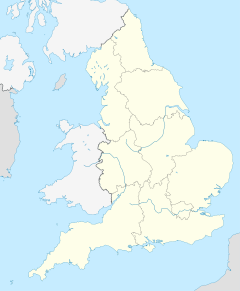Dunkeswell
| Dunkeswell | ||
|---|---|---|
| Gatehouse of Dunkeswell Abbey | ||
| Coordinates | 50 ° 52 ′ N , 3 ° 13 ′ W | |
| OS National Grid | ST1407 | |
|
|
||
| Residents | 1361 (2011) | |
| administration | ||
| Post town | HONITON | |
| ZIP code section | EX14 | |
| prefix | 01404 | |
| Part of the country | England | |
| region | South West England | |
| Shire county | Devon | |
| District | East Devon | |
| Civil Parish | Dunkeswell | |
| British Parliament | Tiverton and Honiton | |
Dunkeswell is a village and civil parish in East Devon , England located about 8 km north of Honiton . In 2001 the Parish had 1,553 inhabitants, in the 2011 Census the population had decreased to 1,361. There is an electoral district of the same name that had 2000 inhabitants in 2011.
geography
Clockwise around Dunkeswell, starting to the north, are the Parishs Hemyock , Luppitt , Combe Raleigh , Awliscombe , Broadhembury and Sheldon .
Part of the municipal area is drained north to the River Culm and then flows over the River Exe to the English Channel , while the rest flows into the sea via a tributary of the River Otter .
history
Dunkeswell is known for its small airfield, now known as Dunkeswell Aerodrome, which was originally established by the United States Navy during World War II , and which continues to serve civil aviation to this day.
The village church, built in 1868, is of interest because of its baptismal font from Norman times.
The Dunkeswell Eco Business Park is located near the airfield and was created to provide space for environmentally friendly start-ups , companies run by young entrepreneurs and women, and companies whose premises had become too small.
Dunkeswell was the birthplace of the Canadian clergyman Henry Scadding .
Wolford Chapel
Dunkeswell Abbey
The abbey is three kilometers north of the village and was founded in 1201 by William Briwere as a Cistercian monastery and offshoot of Forde Abbey . After his death in 1226 he was buried in front of the high altar of the abbey church.
After the dissolution of the English monasteries , the abbey was closed in 1539 and the abbey passed to John Russell, 1st Baron Russell (1485–1555), later 1st Earl of Bedford . A large portion was quickly demolished and only a small portion was used for housekeeping until the 19th century. A parish church was built on part of the property in 1842, with some stone parts from the abbey being reused. The remaining parts of the monastery also include parts of the outer wall of the monastery cells and parts of a gatehouse.
supporting documents
- ↑ Census 2001: Parish Headcounts: East Devon ( English ) In: Neighborhood Statistics . Office for National Statistics. Retrieved September 11, 2016.
- ^ Parish population 2011 . Retrieved September 11, 2016.
- ^ Ward population 2011 ( English ) Retrieved September 11, 2016.
- ^ Map of Devon Parishes ( English , PDF) Devon County Council. Archived from the original on November 2, 2013. Info: The archive link was inserted automatically and has not yet been checked. Please check the original and archive link according to the instructions and then remove this notice. Retrieved September 11, 2016.
- ↑ Dunkeswell Eco-Business Park - About Us ( English ) Archived from the original on April 6, 2009. Accessed September 11, 2016th
- ^ N. Pevsner: South Devon. Penguin Books, 1952, pp. 123-124.
Web links
- Dunkeswell Parish Council , official website (English)
- Dunkeswell Memorial Museum ( September 5, 2008 memento in the Internet Archive )
- uk-genealogy.org Information and pictures of the Holy Trinity Church and the ruins of the abbey

